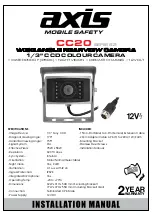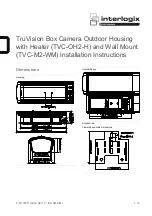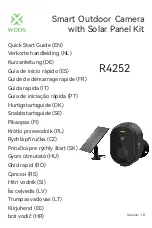
278
•
Additional Reference Information
Nano Series GigE Vision Camera
Additional Lens Parameters (application specific)
There are other lens parameters that are chosen to meet the needs of the vision application. These
parameters are independent of the Nano model (assuming that the Lens Mount and Lens Sensor
Size parameters are correct, as previously covered in this section). A vision system integrator or
lens specialist should be consulted when choosing lenses since there is a trade-off between the
best lenses and cost. An abridged list of lens parameters follows – all of which need to be matched
to the application.
•
Focal Length: Defines the focus point of light from infinity. This parameter is related to the
Nano mount (C or CS mount). See Genie Nano Specifications — Back Focal Distance.
•
Field of View: A lens is designed to image objects at some limited distance range, at some
positive or negative magnification. This defines the field of view.
•
F-Number (aperture): The lens aperture defines the amount of light that can pass. Lenses
may have fixed or variable apertures. Additionally the lens aperture affects Depth of Field
which defines the distance range which is in focus when the lens is focus at some specific
distance.
•
Image Resolution and Distortion: A general definition of image quality. A lens with poor
resolution seems to never be in focus when used to image fine details.
•
Aberrations (defect, chromatic, spherical): Aberrations are specific types of lens faults
affecting resolution and distortion. Lens surface defects or glass faults distort all light or
specific colors. Aberrations are typically more visible when imaging fine details.
•
Spatial Distortions: Describes non-linear lens distortions across the field of view. Such
distortion limits the accuracy of measurements made with that lens.
Optical Considerations
This section provides an overview to illumination, light sources, filters, lens modeling and lens
magnification. Each of these components contributes to the successful design of an imaging
solution.
Illumination
The amount and wavelengths of light required to capture useful images depend on the particular
application. Factors include the nature, speed and spectral characteristics of objects being imaged,
exposure times, light source characteristics, environmental and acquisition system specifics, and
more. The Teledyne DALSA Web site,
, provides an introduction to this
potentially complicated issue. Click on Knowledge Center and then select Application Notes and
Technology Primers. Review the sections of interest.
It is often more important to consider exposure than illumination. The total amount of energy
(which is related to the total number of photons reaching the sensor) is more important than the
rate at which it arrives. For example, 5
µ
J/cm
2
can be achieved by exposing 5mW/cm
2
for 1ms just
the same as exposing an intensity of 5W/cm
2
for 1
µ
s.
Summary of Contents for C1240
Page 215: ...Nano Series GigE Vision Camera Operational Reference 205 ...
Page 275: ...Nano Series GigE Vision Camera Technical Specifications 265 Models M C4090 M C5100 ...
Page 276: ...266 Technical Specifications Nano Series GigE Vision Camera Models M C700 M C1450 ...
Page 277: ...Nano Series GigE Vision Camera Technical Specifications 267 Model M C1950 ...
Page 278: ...268 Technical Specifications Nano Series GigE Vision Camera Model C4900 ...
Page 297: ...Nano Series GigE Vision Camera Additional Reference Information 287 ...
Page 299: ...Nano Series GigE Vision Camera Additional Reference Information 289 ...















































